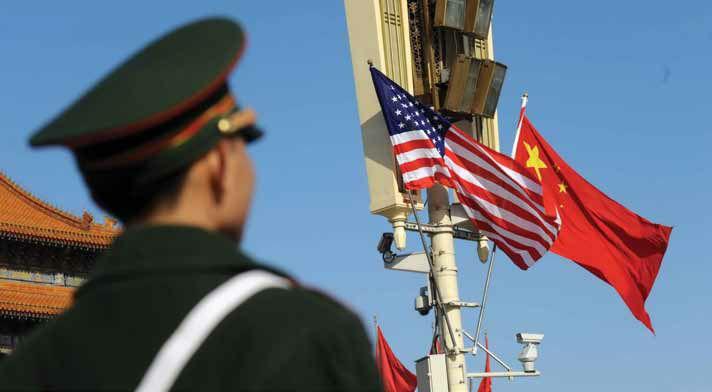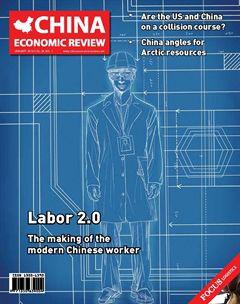Four more years
When a J-15 jet touched its wheels down on an aircraft carrier off Chinas northeastern coast on November 26, many saw it as a symbol of the countrys military modernization. The landing was a first for Beijing, which put the retooled Soviet carrier into service earlier this summer.
Foreign media looked on the event with suspicion, but within China the day was a rare triumph for a country that increasingly feels under siege by its Asian neighbors and the US. Only two weeks later, the homepage of state-run newspaper Global Times featured a slideshow of the US Navy conducting a drone test from the flight deck of its own nuclearpowered carrier – technology that some military analysts believe is aimed at offsetting Chinas recent advances.
Worries are escalating on both sides as China and the US expand their military commitments in Asia. China is investing heavily to improve its outdated navy and air force, while the US is in the midst of a strategic rebalancing that will see 60% of its naval assets deployed to the Pacific by 2020. Barack Obamas visit to Thailand, Cambodia and Burma in late November, his first trip abroad since reelection, suggested the US is doubling down on its pivot to Asia. Countries that are vying with China over territory in the South and East China seas, including Vietnam, Japan and the Philippines, have welcomed Americas renewed interest, but many Chinese condemn it as a veiled effort at containing their rise.
These entangling alliances and shifting relationships in Asia have amplified an already growing distrust between the US and China. In a Pew Research Center poll released in November, 68% of Americans said the US should not trust China. Another Pew poll showed that the percentage of Chinese who saw the USChina relationship as one of cooperation fell to 39% from 68% in 2010.

With Chinas rise set to continue remaking the balance of power in Asia, relations between the worlds largest economies could worsen further. Amid military build-ups, governments will each need to reassess their military goals – otherwise they could be headed for a clash.
The current goals of the US and Chinese military are “basically incompatible,”said Kenneth Lieberthal, the director of the John L. Thornton China Center at the Brookings Institution. “Our stated goal is to maintain the degree of freedom of navigation and activity outside of Chinas territorial waters but inside the first island chain [of Japan, Taiwan, the Philippines and Indonesia] that we have enjoyed for decades. Chinas goal is to not let that happen,” he said. “Both of those are unrealistic.”
History in the making
The rocky ground Obama faces today differs vastly from the smooth start to USChina relations in his first term.
The administration came into office determined that Obama would be Americas first Pacific president, and their efforts to strengthen ties with China initially bore fruit, Jeffrey Bader, a senior diplomat and fellow at the Brookings Institution, a think tank based in Washington, DC, writes in “Obama and Chinas Rise.” In 2009, the administration sent Hillary Clinton to China, Japan and South Korea on her first trip overseas as secretary of state, and the US and China led the way at the Group of 20 in advocating and implementing post-financial crisis stimulus measures.
But relations began to unravel in late 2009 when China and the US clashed at the Copenhagen climate summit over how much responsibility less developed nations should share for reducing carbon emissions. The two nations again ran into serious trouble in 2010 as the Obama Administration arranged an arms sale to Taiwan and held a meeting with the Dalai Lama, engagements it had delayed from 2009 to help smooth relations with the Chinese, Bader writes.
As Obamas first term wore on, it became apparent that the financial crisis had irrevocably changed the dynamics of power. Economically, the crisis spurred both countries to implement some protectionist measures, raising trade tensions. Psychologically, it altered how Americans and Chinese saw their relative positions, destabilizing relations in the process.
Within China, the idea began to emerge that the US was catastrophically weakened and the gap in comprehensive national power between the US and China had shrunk dramatically, Lieberthal said. “That generated a kind of assertiveness and arrogance in China and a broader attitude that ‘We dont have to take no or wait for an answer anymore.”One outcome of this was Chinas more aggressive stance in the South China Sea.
In the US, the attitude toward China also shifted as the business and investment community became less unified on the prospects of the China market, said Damien Ma, an analyst at consultancy Eurasia Group. In an annual survey by the American Chamber of Commerce, 71% of business leaders in Shanghai said that Chinas regulatory environment stayed the same or deteriorated in 2011, up from 63% the year before. As US businesspeople become less enthusiastic as a positive voice for China in Washington, DC, more hawkish attitudes have taken center stage, Ma said.
Arms race
A sharp rise in military spending has given hawks even more fodder for their dissatisfaction. Chinese defense spending rose to US$89.9 billion in 2011 from only US$22.5 billion in 2000. Most of the money has gone to building up Chinas relatively small navy and air force, including acquiring advanced submarines, ballistic and cruise missiles, satellites, anti-satellite weapons and the Soviet carrier. While Chinas neighbors view these investments with suspicion, Chinese argue that the spending is a natural product of the need to take on more responsibility overseas and protect their exports as their economic power grows.
Chinas more aggressive South China Sea claims could partly be a bid to justify this spending, said Ma of Eurasia Group. The Peoples Liberation Army and the Navy have always pictured a conflict with the US over Taiwan as their worst-case scenario and planned their spending accordingly, he said. But a conflict over Taiwan seems a lot less likely these days.“If youre the strategic guys in China and you want to make arguments about how do you get more money and resources,[you might say,] ‘Lets expand into the maritime space; lets look to the South China Seas [sic].”
The US has also shifted resources to Asia to protect its growing economic interests in the region. In 2009, the US Navy and Air Force introduced the AirSea Battle concept, a doctrine that focuses on preserving access to the East and South China Sea for the US and its allies. Clearly provoked by Chinas rise, the doctrine involves improving command-andcontrol, precision strike, advanced missile defenses, robotics, submarine operations and the use of air and space domains.
The Air-Sea Battle concept was followed by Obamas announcement in October 2011 of a broader rebalancing of US resources toward Asia. The administration presented the policy not as an effort to counterbalance China but as finally giving an economically and strategically important region the attention it deserved. However, many analysts agree that Chinas growing power and influence in theAsia-Pacific region ultimately motivated the strategic shift.
Over the past two years, the Philippines, Vietnam and Japan have drawn closer to the US as they oppose Chinese claims in the East and South China Sea, but Washington has been careful not to take a stand on the sovereignty claims, only arguing for preserving freedom of navigation, said Ralf Emmers, an associate professor of security and international studies at Nanyang Technological University in Singapore. Even so, the Chinese have shifted from seeing the US as a stabilizing force to a destabilizing force in Asia, said Ma of Eurasia Group.
Zhao Lei, deputy director of the Institution for International Strategic Studies at the Central Committee Party School, agreed with this idea. “It is usually said that where theres trouble, the US will go. But in the Asia-Pacific, its the opposite: Where the US goes, there will be trouble. The increasing tensions in the Diaoyu and Huanyan islands [called the Senkaku Islands and the Scarborough Shoal by other claimants] are examples of this.”
Managing crisis
Government officials in the US and China are heavily invested in protect-ing a close, cooperative relationship between the worlds two largest economies. But Chinas rapid increase in power has made these dynamics difficult for officials on both sides to navigate. And in 2012 and 2013, almost all of the US cabinet officers who deal with the Chinese, and vice versa, will change, creating an adjustment period for the relationship.
Analysts say Obamas China policy is likely to remain largely consistent with his first term. However, the US pivot to Asia may continue to evolve. Some in Washington have criticized the pivot as excessively focused on security, and they want the administration to focus more on economic aspects in the future, such as increasing membership of the TransPacific Partnership, a free trade pact among countries along the Pacific Rim.
Chinas foreign policy framework also seems likely to evolve. While leaders have expressed discomfort with joining the US to lead the world as a “group of two,”Chinas global investments and interests have outgrown its traditional policy of non-intervention, Ma said. On global issues, China seems set to assume a proactive role, bringing it into more cooperation and more conflict with the US.
Chinese media report that Xi Jinping is stressing a new foreign policy concept to describe Chinas relations with the US, called “new great power relations” (xin daguo guanxi). While its unclear exactly what this philosophy entails, Xi is sending strong signs that he wants to improve US-China relations. While meeting with former US President Jimmy Carter in Beijing in December, Xi called for more“positive energy” for the relationship.
Even so, there is no easy solution to tensions between the US and China in Asia. The US pivot to the region is a longterm and wide-ranging strategy, as is the defense of maritime claims for China, Japan, the Philippines and Vietnam. “So the key word here is not resolution; its management,” Emmers said.
A necessary part of managing this relationship will be clear communication. US and Chinese officials must carry out difficult discussions about their primary goals in Asia and whether they can make these goals more compatible by exercising mutual restraint, said Lieberthal. Otherwise, strengthening military capabilities on both sides may only worsen relations.“Everyone has spent a lot, and the world is less safe at the end of the day,” Lieberthal said.

